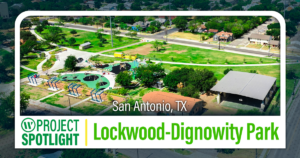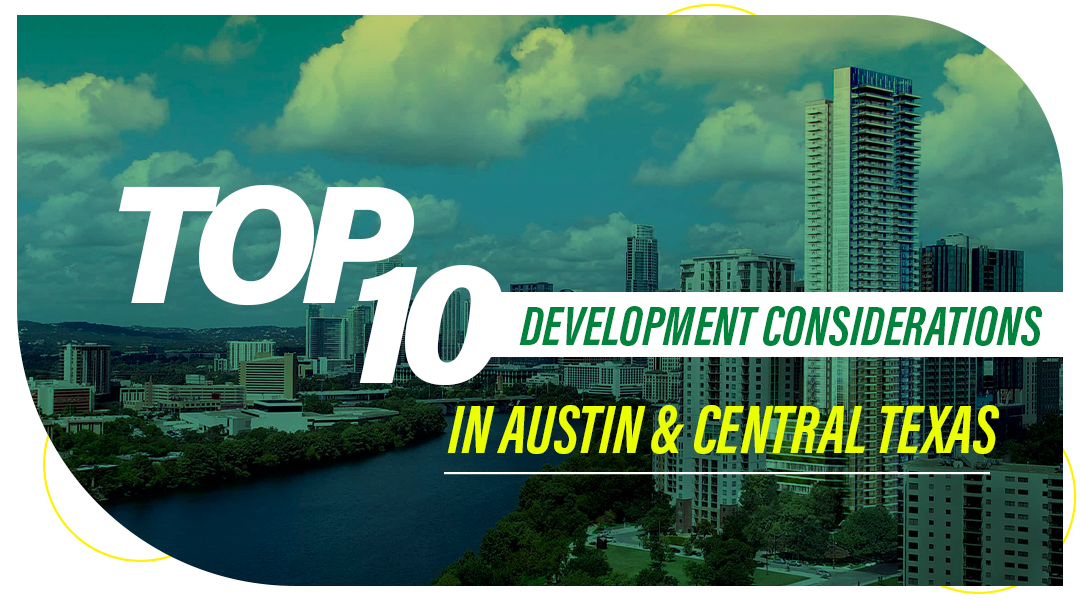
Project Spotlight: Lockwood-Dignowity Park
WGI provided a suite of engineering services for the redevelopment & unification of Lockwood and Dignowity Parks in the heart of San Antonio, TX.
Learn from award-winning professionals — explore our whitepapers, blogs, and the latest industry updates.
Join our dynamic organization of engineers, land surveyors, landscape architects, environmental scientists, and architects!
Talk to a market leader today! We’ll answer any questions you have about our professional services.

Download this article as a PDF
Every development project poses unique site development challenges. Local land-use and zoning requirements can complicate development plans; the site’s geographic and geological characteristics can necessitate creativity and flexibility; and of course, local politics often come into play. As you prepare your real property for development, it’s essential to understand and face the zoning, political, and unique site challenges — and create a comprehensive strategy for overcoming them.
Here are the top 10 site development considerations for your project in Central Texas:
Most cities utilize zoning maps to demonstrate permitted land uses. They will serve as your guide for how you can and can’t develop a given site. The map breaks down geographic sections of the city or town into categories of development, with specific permitted uses and building restrictions for each category.
The first step in any development is understanding how these land-use regulations impact your intended development, and whether your plans are consistent with community standards. Based on your review of current zoning regulations, you’ll recognize if your project can be built “as of right,” or if zoning changes are required. Typically, any necessary zoning changes require approval at one or more public hearings.
Development impacts the environment, so most projects encounter some type of environmental regulations or requirements. Local communities understandably want to make sure that site development doesn’t damage local ecosystems.

There are many potential environmental considerations, such as endangered species, wetlands, and open-space requirements. Also, a geological assessment might be necessary to determine whether the land you’re developing has sensitive features, such as sinkholes, caves, and wetlands, that could impact the project (and be impacted by it).
Wetlands are very sensitive areas, and sinkholes and caves are vital because they recharge local-area aquifers — in Central Texas, the Edwards Aquifer is a water-supply aquifer recharged via caves and sinkholes. Caves also tend to be homes to rare or endangered species.
Specific to the City of Austin, development requirements (such as impervious cover) and environmental setbacks can vary based on local watersheds. Urban watersheds tend to allow greater impervious cover.

Suburban, water-supply suburban, rural, and water-supply rural watersheds all feature different restrictions. Other environmental considerations aren’t related to ecosystems, such as historic preservation and site contamination.
Site contamination is a particularly important issue because as communities continually become more densely developed, it’s often necessary to reclaim land that was previously used for heavy industrial purposes. In these situations, the land is often contaminated and remediation is required prior to redevelopment, particularly when being converted to residential, medical, or education land uses.
For any development, water is a constant concern. Allowing for proper drainage is vital, not just to keep the site from flooding but to prevent downstream flooding that could impact other areas and contaminate water sources.
Water quality is always a primary consideration. Natural or engineered filtering systems are often required to clean the first flush of stormwater runoff, either by an appurtenance inside a pipe or sand filter basins.
In some jurisdictions — including the City of Austin — water-quality treatment is regulated as an environmental consideration rather than a drainage feature. Practically speaking, drainage systems and water-quality treatment tend to work in conjunction.
Another essential concern for any new development is water and wastewater capacity. Can sewer systems handle its discharge? Can water systems provide sufficient water to meet the new development’s needs, including for fire flow?
Pipes have finite capacity and if existing infrastructure can’t meet your requirements, you may need to budget for additional water upgrades. Consequently, you can assume planning is necessary for future upgrades when your water and wastewater needs inevitably grow over time.
Traffic is a consistently significant concern for local leaders and residents. It’s important to understand how your development will impact local roadways. You might need to plan physical improvements to the roadway network, and/or for impact fees used to underwrite the cost of new road infrastructure.
If your development is going to increase traffic on local roads, even if those impacts are felt a mile or more from your development, you may be expected to underwrite costs of creating new highway exit and entrance ramps, the addition of new traffic signals, or dedicated turn lanes. More likely than not, you’ll be expected to conduct a traffic impact analysis (TIA) to determine the anticipated impacts and how to best mitigate them.
Flooding is a problem across the United States, and its impacts are exaggerated in localized areas based on weather patterns and geography. Central Texas is known for flash flooding during heavy rainfall events.
FEMA flood insurance rate maps (FIRM) demonstrate known floodplains, while site-specific drainage studies are able to identify localized flooding conditions or waterway setbacks not readily apparent on the FEMA maps.
Additionally, most navigable waterways are designated as Waters of the U.S. and require Army Corps of Engineers sign-off. If your project impacts a navigable waterway, expect to be working with the Corps — a federal agency — to obtain approvals for your project.
Impact fees are the checks you must write to satisfy community requirements before you even put a shovel in the ground. These fees can cover improvements to water and wastewater systems (AKA tap fees), affordable-housing fees, fees-in-lieu of parkland dedication, tree-removal mitigation fees, or multiple other things that communities compel based on their local ordinances.
These soft costs may not be part of your development plan, but they are increasingly common. It’s wise to anticipate them in your budgeting.
Most major cities have affordable housing requirements mandating that a specific amount of low-cost housing is created in conjunction with new development. Others offer bonus programs for including housing. Each community has different requirements, so it’s important to know the community’s expectations upfront.
Neighborhood organizations and local elected officials have a substantial impact on entitlements and permitting, particularly in urbanized communities.
Some cities give neighborhoods more power to preserve historical buildings and infrastructure, while others rely on community leaders (neighborhood organization leaders, planning area leaders), appointed bodies (planning commission), and/or elected officials (city council) to help guide development and urban planning policy.
It’s essential to know who is influencing and voting on an individual project, and then establish relationships with those decision-leaders. One truism in development is that all land use is political, and all politics is local. You never want a local leader or elected official to read or hear about a project in the local media — they should hear about it first from you.
New development projects and parking should always be considered together. Depending on your jurisdiction, there may exist both a maximum and a minimum parking requirement. Additional accessory requirements may include screening measures, parking for electric vehicles (vehicle-charging stations), providing Americans with Disabilities Act (ADA)-accessible, and bicycle parking.
It is not unusual for parking reductions to be available in certain geographic areas, like central business districts, universities, or those areas well-served by public transit.
One final consideration for parking should include off-street loading and unloading areas, which can be utilized by transportation network companies (TNCs) like Uber or Lyft to safely pick up and drop off passengers. These areas may also be used for deliveries, moving vehicles, or valet service.
Every property is unique, and no two sites will have the same unique development opportunities and constraints. Understanding the zoning, political, environmental, and infrastructure challenges prior to starting your project makes the entire process more orderly and predictable.
Are you in the early stages of a new project? Civil Engineering and Site-Development Permitting are the critical paths for your development project’s success.
The site and land development professionals at WGI have market-leading experience in the successful delivery of thousands of development projects nationwide on behalf of private clients, higher-education institutions, and public municipalities. Our engineers and land planners are local experts — with offices in Austin and Central Texas — augmented with the technical footprint and proficiency of a national design firm.
Contact our team today and let’s make your next project more successful — together.

WGI is a national design and professional services firm leading in technology-based solutions for the construction of public infrastructure and real estate development. At WGI, we’re providing Tomorrow’s Infrastructure Solutions Today.

WGI provided a suite of engineering services for the redevelopment & unification of Lockwood and Dignowity Parks in the heart of San Antonio, TX.

Considering developing land in Central Texas? There are several important steps that you need to take, and one of them is Land Subdivision.

As a mobility company, WGI is helping clients adjust to technology trends shaping not only transportation, but urban design, parking, and broader access to destinations. Among trends, no other technology has grabbed attention quite like shared electric scooters.

Melissa’s addition to the team solidifies WGI’s leadership in helping communities harness the benefits of much-needed infrastructure projects throughout the nation.

The future is fast approaching and 5G is here. Discover how you can fully leverage what 5G technology will ultimately unleash.

WGI moves up 12 spots on the Engineering News-Record (ENR) 2021 Top 500 Design Firms List!
You’ve been searching for a place like WGI. We look forward to meeting you soon.
Sign up to receive emails to hear our latest news and achievements in our monthly newsletter.
Enter your zip code, and we’ll personalize your experience with local projects, office locations, team members, and more.
WGI supports its associates with meaningful opportunities for growth, strong benefits and perks, while we work collaboratively with clients and co-consultants to shape and improve communities.






WGI is a dynamic organization with opportunities nationwide for engineers, land surveyors, landscape architects, environmental scientists, and architects.